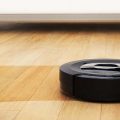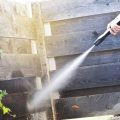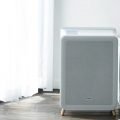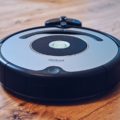Table of Contents
If you’re just starting out with any form of home crafting and you’ve been thinking of investing in a sewing machine, you’re in for a treat this week.
In today’s best sewing machine reviews, we’ll showcase 5 of the best products at all price points from the hardest hitting brands.
We’ll also give you a brief guide to simplify your buying decision.
5 Best Sewing Machine Reviews
Later this week, we’ll be covering embroidery machines and overlocker machines so you’re in safe hands whatever kind of projects you have in mind.
We’ll get straight into those sewing machine reviews right now…

You can’t read any collection of sewing machine reviews without encountering the classic Singer 4423 front and center.
While this is marketed as a heavy-duty machine and build quality is top-notch, the 4423 is most certainly not an industrial machine so keep your expectations reasonable. You’ll find it more than up to the job for most reasonable home crafting projects.
23 inbuilt stitches gives you ample flexibility and you’ll be able to churn through work at the impressive rate of 1100 SPM.
You’ll get some decent accessories thrown in…
- All-Purpose Foot
- Zipper Foot
- Buttonhole Foot
- Bobbins
- Needles
- Dust Cover
- Thread Spool Caps

This machine is relatively compact and pretty lightweight so you’ll be able to carry it to class without straining yourself.
The automatic needle threader gives you a welcome layer of convenience and the 4423 is suitable for all levels including absolute beginners.
If you’re looking for an affordable but effective entry point into the world of sewing machines, the Singer 4423 is well worth further investigation.
Pros.
- 23 programmed stitches
- Automatic needle threader
- 1100 stitches per minute
- Generous accessory bundle
- Rock solid metal frame
Cons.
- Not suitable for heavy commercial work

Next up in our sewing machine reviews is an enduring classic from Brother, the CS6000i.
If you’re looking for a feature-laden machine that’s remarkably easy to use, the affordable but dependable CS6000i delivers in fine style.
A broad range of inbuilt stitches including a decent spread of decorative stitches gives you the scope for a variety of projects including quilting.
You’ll get 7 types of 1-step buttonholes and 9 presser feet which is more than you could hope for at this price point.
Adjustable speed is a nice touch and adds a further layer of customization to this already flexible sewing machine.
Automatic threading and an easy winding bobbin bolster the extremely user-friendly experience.
If you’re looking for a straightforward yet feature-rich sewing machine from a brand you can trust at a pocket-friendly price, you can’t beat the Brother CS6000i. If you’re in any doubt, why not pop to a big box store and road test one. There’s nothing to stop you then buying it online if you can get a better price!
Pros.
- 60 integrated stitches
- User-friendly stitch selector
- Adjustable speed
- On-board free arm
- Hard case included
Cons.
- Cannot tweak pressure of presser foot
- Some plastic internal parts

We normally avoid covering more than one product from any given brand but in the world of sewing machines, Singer hit so hard it’s impossible to avoid highlighting another of their incredibly popular domestic sewing machines, this time the 7258.
Relatively brisk at 750 SPM, you’ll enjoy a massive choice of 100 programmed stitches available at the push of a button. From dress making and embroidery to quilting and home furnishings, this cost-effective powerhouse gives you enormous freedom in a compact package.
Although this sewing machine comes driven by some impressive tech, don’t worry about being confused since it’s extremely simple to operate.
You’ll get 10 presser feet and an assorted bundle of sundry accessories so you’ve got everything you need to get going straight out the box.
If you’re still in any doubt about investing, the rock-solid 25-year warranty should give you complete peace of mind.
The Singer 7258 is a ruthlessly efficient and incredibly versatile sewing machine from a legendary brand that won’t run you a fortune. What’s not to like?

Pros.
- 100 inbuilt stitches
- 750 stitches per minute
- Automatic needle threader
- Fully computerized but user-friendly
- 25-year warranty speaks for itself
Cons.
- Limited stitch width
- No carry case is a disappointment
- No lever for lowering feed fogs

As we edge to a close with our sewing machine reviews, we’ve got the budget 2212 from the ever-reliable Janome.
If you’re looking for a heavy-duty sewing machine for semi-professional use, the 2212 is not for you. If, on the other hand, you’re looking for an affordable domestic machine with a pretty small footprint, the Janome comes up trumps.
Although you’ll be limited to 12 stitches, not everyone wants the confusion of choosing from 100 options. The simplicity of the Janome is, for many, one of its key selling points.
You’ll be able to alter the length and width of your stitches to suit the project at hand.
Bear in mind this machine runs on 110 volts only. If you’re outside of the US and your power supply runs on 220 volts, you’ll need to buy a transformer so we’d recommend looking at an alternative.
If the voltage is right, though, the Janome 2212 hits the spot in no uncertain terms.

Pros.
- Sew almost any fabric with ease
- 12 stitches onboard
- Awesome price to performance ratio
- Ideal for all levels of experience
- Integrated thread cutter
Cons.
- Some tendency to jam
- Minimal workspace on the machine

Last but by no means least in our sewing machine reviews is the pricey but lethal HZL-DX from Juki, a true industry titan.
A pacey steed at 1050 SPM, you’ll be able to adjust the speed downward if you need a little more control. This machine is extremely flexible but we should state that it’s very much designed for capable crafters looking to enhance their skills rather than beginners.
The touchscreen interface is responsive and a pleasure to use. If you’re not a tech-lover, you won’t be baffled and everything is intuitive and straightforward.
Threading is also a breeze and the bobbin preparation and winding a cinch. In all respects, the Juki is a dream to use.
If you’re already pretty handy with a needle and you’ve got a more flexible budget, you’ll be in safe hands with the Juki HZL-DX7.
And the kicker?
While it’s still not cheap, if you act quickly you can pick up this outstanding sewing machine at an aggressive discount.

Pros.
- Extremely user-friendly
- 1050 stitches per minute
- Free motion stitching
- Intuitive touch screen
- Fine-tune the speed to the application
Cons.
- Pretty expensive
- Not ideal for beginners
OK ...
Now you’ve had a glimpse at 5 of the best sewing machines on the market, what should you take into account when you’re on the buying trail
What To Think About When You’re Looking For Best Sewing Machine
Buying a sewing machine is quite an investment so don’t rush in headlong.
We’ll laser in on some considerations that will streamline your buying decision and help you get the machine of your dreams.
Type of Sewing Machine
Off the bat, sewing machines are cleaved into 2 broad categories:
- Domestic
- Industrial
Domestic Sewing Machines
Domestic sewing machines are usually fairly compact and lightweight.
Plastic features throughout and this type of machine is not braced to deal with prolonged or particularly heavy-duty crafting.
There are 4 general types of domestic sewing machine…
- Manual Sewing Machine: These rugged workhorses remain popular today even though technology has introduced a great deal of computerization to sewing. You’ll need to use a foot pedal since these are not electronic but a manual sewing machine still makes a smart starting point for some
- Electric Sewing Machine: Single motors power the needle on electrics sewing machines. The foot pedal is also electronic. You’ll be able to use both hands to focus on your workpiece and you’ll get more done in less time if you go electric
- Computerized Sewing Machine: Packing far more advanced functionality, once you’re a sewing maestro it’s time to step up to computerized machines. That said, some models are beginner-friendly just make sure to buy inline with your needs. You’ll be able to upload designs using a USB port so you can enjoy a great deal of customization
- Overlocker Sewing Machine:
Industrial Sewing Machine
Industrial sewing machines are expressly designed for use in a factory setting.
They’re constructed from premium materials and built to withstand sustained punishment. As a result, industrial machines are bigger and heavier than a domestic equivalent.
Commercial sewing machines can be divided into 4 types depending on the way the arm and needle post is designed…
- Flat Bed: Looks much like a regular sewing machine. Used for sewing flat material together
- Post Bed: Used for glove and boot making, post bed machines have a vertical column extending from a flat base
- Cylinder Bed: With a narrow horizontal column, cylinder bed machines are great for working with saddles, shoes and cuffs
- Off-The-Arm: Seldom seen, this type of industrial sewing machine comes to the fore for sleeves and shoulders
Price
Now you’re clear on what type of sewing machine gels with your needs, focus on budget next.
Set a price and stick to it. This will immediately narrow your options and make your decision easier before you even get started.
How Many Stitches Do You Really Need?
Sewing machines come offering far more than just a straight stitch and a zigzag stitch. Thing is, just those basic stitches will suffice for most needs so don’t get hung up on the number of stitches just for the sake of it.
Think about your intended usage and look for a machine that will deliver without going over the top.
Is Stitch Length Adjustable?
It’s vital you can manipulate the length and width of stitches.
You should also check if the machine you’re interested in carries out reverse stitching automatically. This is handy when it comes to seams.
Attachments
Different machines come with varying attachments as standard with others costing extra.
A wide choice of presser feet is crucial if you’re going to work with different materials. Here are some of the most common presser feet:
- Buttonhole Foot, Blind Hem Foot, Zipper Foot: Clothes making
- Walking Foot, ¼-Inch Foot: Making quilts
- Freehand Embroidery Foot: Freehand quilting
You should also check the presser feet are well constructed and easy to swap out.
Degree of Computerization
If you want touch-screen functionality and programmability, you’ll need to dig deeper so decide what features you really need and will make use of. There’s no right or wrong answer when it comes to the level of tech on your machine, it’s simply a case of getting something that meshes with your crafting needs.
As well as offering up a wide range of embroidery and non-standard stitches, you’ll also be able to import and work with your own patterns on a computerized sewing machine.
Noise Level
While sewing machines make an almost comforting sound, you should think about how noisy the machine you’re thinking about is when it’s running at full clip. This can affect your experience when you’re sewing.
Think also about when you’ll be sewing and if you plan to burn the night oil, you might want to focus on a machine that runs as quietly as possible.
Motor Power
The heavier the motor in your sewing machine, the stronger it will be.
If you’re aiming to do lots of heavy-duty projects then a plastic machine is unlikely to fit the bill. If you intend to carry your machine from car to class, on the other hand, the last thing you want is a hulking unit.
As with all elements of your purchase, think closely about your specific circumstances and buy accordingly.
A Final Word
Hopefully, you’ll now have a firmer idea of which sewing machine would make the best fit.
Come back next week for our embroidery machine and overlocker machine reviews if you still haven’t found what you’re looking for!





